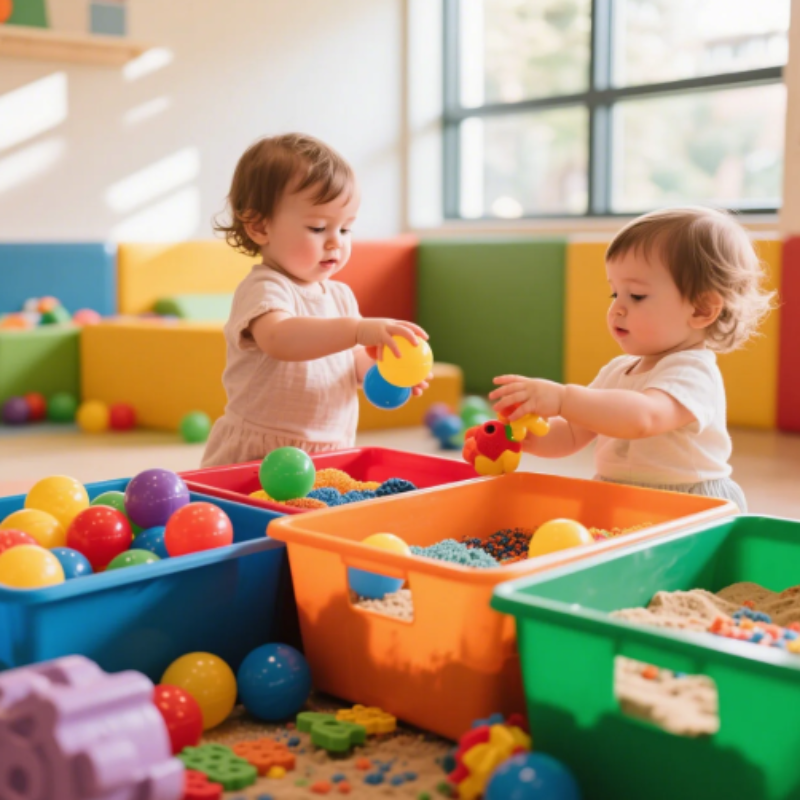As toddlers explore the world around them, their senses—sight, smell, touch, taste, and hearing—become essential tools for learning and discovery. Sensory play not only entertains but also supports crucial developmental skills like motor coordination, cognitive abilities, and language development. The best part? Sensory play doesn’t have to be complicated or messy. With just a few simple ideas and materials, you can create an engaging and educational experience for your little one.
Here are some easy and fun sensory play ideas to try with toddlers:
1. Water Play: Splashing into Fun
Water play is a classic, and for good reason! It stimulates the senses of touch and sight and offers endless possibilities for exploration.
- What you’ll need: A shallow container, small plastic toys, measuring cups, sponges, and water.
- How to play: Fill a bin with water and let your toddler dip their hands in, splash, and explore. You can add small toys like rubber ducks, boats, or even plastic animals to make the experience more fun. Add sponges for squeezing and measuring cups for pouring to enhance motor skills.
Water play is an excellent way for toddlers to explore texture and practice hand-eye coordination as they manipulate the toys and tools.
2. Mess-Free Painting: Artistic Expression Without the Mess
You don’t have to worry about paint getting everywhere with this simple and safe painting activity!
- What you’ll need: Transparent sheets or plastic bags, water-based paints, and food coloring or edible materials like yogurt or pudding.
- How to play: Put a sheet of plastic or a ziplock bag on a flat surface and pour some edible paint or colored pudding inside. Seal the bag and let your toddler press, squish, and move the paint around. This encourages creativity while keeping everything contained—no mess to clean up!
3. Texture Exploration: Let’s Feel It!
Toddlers love to touch and feel different materials, and texture bins are a fantastic way to introduce them to new sensations.
- What you’ll need: Items like rice, pasta, fabric swatches, foam, and cotton balls.
- How to play: Fill a container with any textured materials and allow your toddler to explore with their hands. You can even create a sensory path where they walk barefoot on different textures, helping them connect to the world through touch.
4. Outdoor Sensory Play: Nature’s Playground
Sometimes, the best sensory experiences are right outside the door. Nature offers rich opportunities for sensory stimulation, and a simple walk can turn into a sensory adventure.
- Nature Walks and Exploration: Go on a walk and encourage your toddler to explore natural textures—leaves, flowers, rocks, and even grass. Ask them to touch and feel the different materials while listening to the sounds around them.
- Sand Play: If you have access to a sandbox or a beach, bring in some toys like small shovels, buckets, or even toy animals for digging and building. Sand is an amazing sensory material, providing a tactile experience that toddlers can’t get enough of.
5. Interactive Sensory Activities: Playful Learning
Interactive sensory games not only engage your toddler’s senses but also stimulate their creativity and problem-solving skills.
- Playdough Fun: Whether store-bought or homemade, playdough offers endless opportunities for sensory exploration. Let your toddler squish, roll, and mold shapes while developing fine motor skills. You can even add some glitter, sand, or beads to the dough for additional texture.
- Bubbles: Simple but exciting, bubbles are perfect for sensory play. Blow bubbles and encourage your toddler to chase, pop, and watch them float through the air. Use different bubble wands for a variety of shapes and sizes—this will add more visual excitement!
6. Sensory Games for Learning: Exploring Through Play
Sensory games can also serve as learning tools, helping toddlers connect sounds, smells, and sights to words and concepts.
- Sound Exploration: Introduce musical instruments like drums, xylophones, or maracas. Toddlers love to explore sound, and these instruments allow them to experiment with rhythm and volume. You can also play sound-matching games with animal sounds or everyday noises.
- Scent Exploration: Using safe and simple scents, such as fruits, flowers, or even spices like cinnamon, allows toddlers to practice identifying different smells. Create a “smell-and-tell” game where they try to match a scent to a picture of the object.
7. Conclusion: Sensory Play—The Fun Way to Learn
Sensory play is so much more than just a fun way to pass the time—it’s an important part of your toddler’s growth. By engaging their senses, you help them explore and understand the world around them while developing essential cognitive, motor, and emotional skills.
So, the next time you’re looking for an activity that’s both fun and educational, reach for one of these simple sensory play ideas. Not only will it keep your toddler entertained, but it’ll also foster a deeper connection between their developing mind and the world they’re discovering.
Ready to dive into sensory play? Which activity will you try first? Share your experiences in the comments below!





